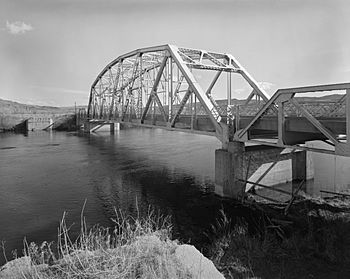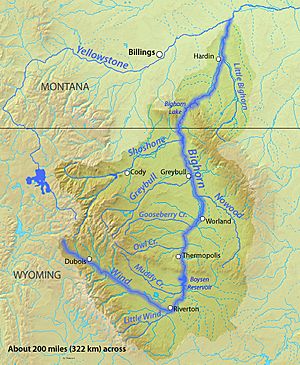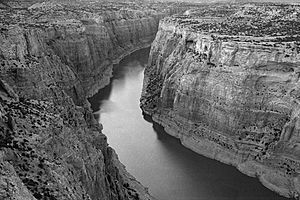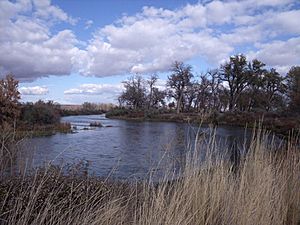Bighorn River facts for kids
Quick facts for kids Bighorn River |
|
|---|---|

The CQA Four Mile Bridge over Bighorn River
|
|

Map of the Wind-Bighorn River
|
|
| Native name | Iisaxpúatahcheeaashisee |
| Other name(s) | Great Horn River |
| Country | United States |
| State | Wyoming/Montana |
| Cities | Dubois, Crowheart, Johnstown, Riverton, Thermopolis, Lucerne, Kirby, Winchester, South Flat, Mc Nutt, Worland, Washakie Ten, Manderson, Basin, Greybull, Fort Smith |
| Physical characteristics | |
| Main source | Two Ocean Mountain Wind River Range, Teton County 9,760 ft (2,970 m) 43°44′50″N 110°04′27″W / 43.74722°N 110.07417°W |
| River mouth | Yellowstone River Bighorn, Montana, Treasure County 2,687 ft (819 m) 46°09′18″N 107°28′28″W / 46.15500°N 107.47444°W |
| Length | 185 mi (298 km) |
| Basin features | |
| Basin size | 22,885 sq mi (59,270 km2) |
| Tributaries |
|
The Bighorn River is a long river in the western United States. It flows through the states of Wyoming and Montana. This river is a tributary of the Yellowstone River. This means it flows into the Yellowstone River. The Bighorn River is about 461 miles (742 km) long. It got its name in 1805 from a fur trader named François Larocque. He saw many bighorn sheep along its banks.
The Bighorn River actually starts as the Wind River in Wyoming. The Wind River changes its name to the Bighorn River at a place called the Wedding of the Waters. This spot is near the town of Thermopolis. From there, the river flows through a large area called the Bighorn Basin.
When the river reaches the border with Montana, it turns northeast. It then flows through the Crow Indian Reservation. Here, the Yellowtail Dam creates a large lake called Bighorn Lake. This lake and the surrounding canyon are part of the Bighorn Canyon National Recreation Area. The Little Bighorn River joins the Bighorn River near the town of Hardin, Montana. About 50 miles (80 km) further downstream, the Bighorn River flows into the Yellowstone River.
The River's Journey

The Bighorn River starts high in the Rocky Mountains as the Wind River. Its source is near Two Ocean Mountain in Wyoming. The Wind River flows southeast, passing towns like Dubois and Riverton. In Riverton, it meets the Little Wind River.
After this, the river turns northeast and then north. It flows into Boysen Reservoir, which is a lake made by the Boysen Dam. Below the dam, the river enters the Wind River Canyon. Here, the river gets narrow and has many fast-moving parts called rapids.
At the end of the canyon, the river widens out. This is the "Wedding of the Waters" where it officially becomes the Bighorn River. It then enters the Bighorn Basin. The Bighorn River continues north through towns like Thermopolis, Worland, and Basin.
Near Greybull, the Greybull River joins the Bighorn. About 30 miles (48 km) north, the Bighorn River flows into Bighorn Lake. The Shoshone River also joins the Bighorn in this lake. North of this point, the lake narrows as the river enters the Bighorn Canyon. This is where the river crosses into Montana.
At the end of the canyon, the river flows through Yellowtail Dam. The river then turns northeast and enters the Great Plains. Near Hardin, the Little Bighorn River flows into the Bighorn. Finally, about 50 miles (80 km) downstream, the Bighorn River empties into the Yellowstone River.
What the River is Called
The Bighorn River has been known by a few different names. Sometimes it was called the Great Horn River. In the Apsáalooke language, its name is Iisaxpúatahcheeaashisee. This means "Large Bighorn Sheep River" in English. The Gros Ventre people call it Gros Ventre: ʔɔ́tééíníícááh, which means "wild sheep river".
See also
 In Spanish: Río Bighorn para niños
In Spanish: Río Bighorn para niños


